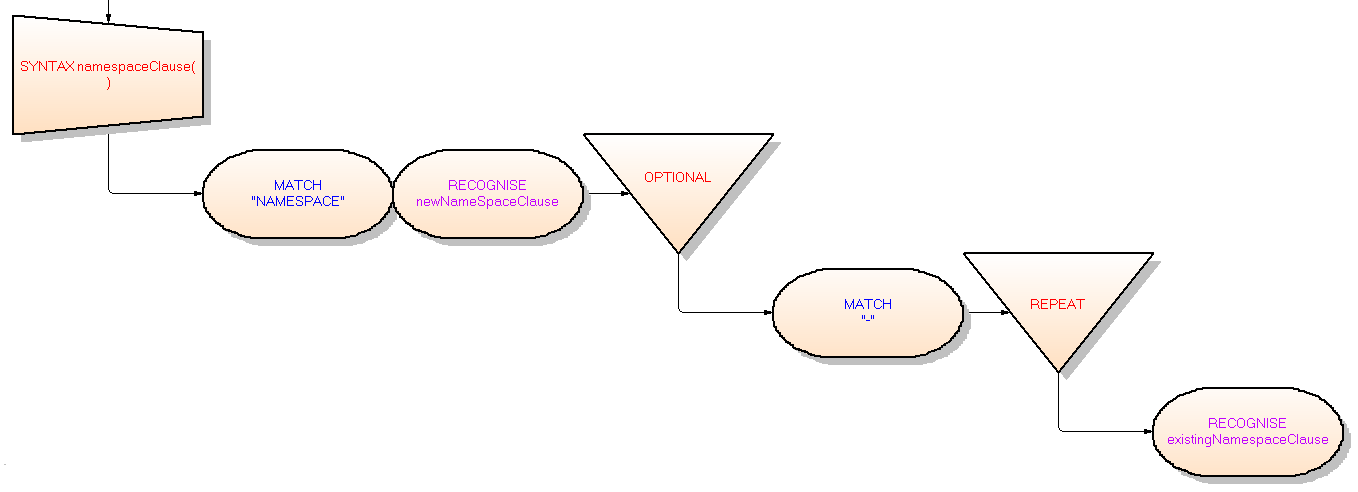Table of Contents
- Namespaces : Context
- Namespaces : Examples
- Namespaces : Semantics
- Namespaces : Data Definition
- Namespaces : Syntax
- (1.1) Data Types
- (2) Types
- (3) Enums
- (4) Signals
- (5) Singletons
- (6) Classes
- (6.1) Finite State Machines
- (7) Expression Syntax
- (7.1) [wiki:WhatAboutIdentifiers What about identifiers (Expression …
- (7.2) Compile Time Type Checking
- (8) [wiki:compoundStatementsLlambdas Lambda Statements (Compound …
ClassDefinition
CompileTimeTypeChecking
DataTypes
EnterTheIdeaBase
EnumDefinition
ExpressionSyntax
FiniteStateMachines
NotationExplaination
SignalDefinition
SingletonDefinition
TypeDefinition
WhatAboutIdentifiers
compoundStatementsLlambdas
1) Namespaces
Namespaces : Context
We need to create name spaces.
Namespaces are
- a labeled/named subset of identified/labeled content,
- content can then be precisely identified with a compound identfier
- the conjuction of the subset name and the content name.
- commonly structured as nested hierarchies to allow reuse of names in different contexts.
- typically employed for the purpose of grouping symbols and identifiers around a particular functionality
- to avoid name collisions between multiple identifiers that share the same name.
- hierarchical, ie sets of namespaces can be nested within another namespace
Namespaces : Examples
In TDX
NAMESPACE $project
Puts anything following in the current project context
NAMESPACE $project:subComponent
OR
NAMESPACE subComponent
Puts everyting that follows into the project's subComponent namespace
NAMESPACE subComponent - $system:language
OR
NAMESPACE subComponent - language
OR
NAMESPACE subComponent - $dxlib:codelib
Puts everything that follows into the project's subComponent namespace AND incorporates the system defined "language" namespace contents accessible to the project.
NB.
The default namespace is $project and coresponds to the base directory of the current project.
The default namespace to be included is $system and coresponds to a file refererd to by the dxiner environment variable.
If any other $name is used, it coresponds to a system based environment variable containing a directory where the coresponding ".tdx" file can be found. The variable can consist of a selection of paths, separated by semi-colons.
In VDX
Namespaces : Semantics
Namespaces : Data Definition
To store namespaces we need a structure similar to that detailed below ... explaination of the notation
In TDX
NAMESPACE $project:tdx - $system:lang
// however $project is implied and not really needed
SINGLETON design
namespace ourNameSpaces = NEW namespace("system")
SYNTAX
textualDesignClause := ( designClause )+;
designClause := namespaceClause ( designComponentClause )+;
designComponentClause := ... ;
CLASS namespace(ubyte$ name)
namespace{} subSpaces
namespace(namespace) addNamespace(newNameSpace) =
{
subSpaces->add(newNameSpace)
RETURN newNameSpace
}
SYNTAX
namespaceClause := "NAMESPACE" newNameSpaceClause
( "-" ( existingNameClause )+ );
newNameSpaceClause := ( "$" ident ( ":" ident )* | ident ( ":" ident )+ );
existingNameClause := ( "$" ident ( ":" ident )* | ident ( ":" ident )+ );
In VDX
Namespaces : Syntax
INFORMATION MODEL
PROCEDURAL MODEL
(1.1) Data Types
(2) Types
(3) Enums
(4) Signals
(5) Singletons
(6) Classes
(6.1) Finite State Machines
(7) Expression Syntax
(7.1) What about identifiers (Expression Syntax) ?
(7.2) Compile Time Type Checking
(8) Lambda Statements (Compound Statements)
Attachments
- existingNamespaceClause.png (28.1 KB) - added by archibald 8 years ago.
- namespaceClause.png (15.1 KB) - added by archibald 8 years ago.
- newNamespaceClause.png (27.0 KB) - added by archibald 8 years ago.
- namespace.png (27.4 KB) - added by archibald 8 years ago.




